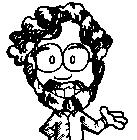Scenes from the Future
When I arrived in Belarus last month, I quickly felt at home. It was my first visit to Belarus, but many things felt familiar. At dinner the first night, I ordered from the section of the menu labelled “traditional Belarusian food,” and it brought back memories of dinner with my grandparents when I was growing up. All four of my grandparents were born in nearby Ukraine before coming to the United States 100 years ago, and they had introduced me to borscht, potato pancakes, and many other foods that I re-experienced at my meals in Belarus.
But it wasn’t just the food that made me feel at home in Belarus. I felt most at home when I visited classrooms and after-school clubs, and saw children creating projects with Scratch. When my research group at the MIT Media Lab developed the Scratch programming language and online community, we hoped that children around the world would use Scratch to create their own interactive stories, games, and animations. So I was excited to see how children throughout Belarus are using Scratch to create projects, share ideas, and learn new things.
Of course, one motivation for the Scratch initiatives in Belarus is to develop future programmers and computer scientists for the Belarus workforce. But the overall goals are much broader. The Belarus Hi-Tech Park uses the phrase “Programming is the Second Literacy” to describe its nationwide educational initiative. I really like this phrase. I see programming as a new way for children to organize, express, and share their ideas — just as they do with writing.
As I travelled through Belarus, I saw children using Scratch to express themselves in many different ways. At after-school clubs in Minsk, children were using Scratch to create role-playing games, interactive tutorials, science simulations, and many other types of projects. At a computer lab in Orsha, students proudly demonstrated a wide variety of robotic creations — and one student created an animated story about my visit to Belarus. In Orsha, I participated in an awards ceremony for a regional programming competition, and I liked the way that singing and dancing performances were integrated with the programming activities, indicating that programming is becoming part of the broader culture.
Educators in Belarus are still trying to figure out the best ways to integrate programming into the school curriculum. In Minsk, I participated in a roundtable discussion with educators, policy-makers, and educational researchers. One central tension was between “rigor” and “creativity.” Some participants felt that schools should focus on a disciplined, rigorous approach for teaching core skills and core concepts. Other participants advocated for a project-based approach to encourage creative thinking and creative expression. I argued that this is a false dichotomy: I believe that students can and should learn core skills in the process of working on creative projects. As I see it, students are more likely to make strong connections to core concepts and skills while they’re working on projects they deeply care about.
In fact, right after the roundtable discussion in Minsk, there was a great demonstration of how rigor can be combined with creativity. A group of middle-school students made presentations about the Scratch projects that they had created in an after-school program supported by EPAM (a high-tech company founded in Belarus). All of the students had been given the same challenge: create a Scratch project showing “Scenes from the Future.” One student created an animated story showing how “smart contact lenses” could provide you with background information about the people you meet. Another project featured a veterinarian’s office in the future, including a special 3D printer producing new body parts for injured animals and nano-robots for fighting animal diseases.
I don’t know if any of those inventions will actually be available in the future. But as I watched the students present their “Scenes from the Future” projects, I felt that I was already seeing a “Scene from the Future.” As the students programmed and shared their Scratch projects, they were learning to think creatively, reason systematically, and work collaboratively — skills that will be essential for everyone in the future. It was exciting for me to see that more children in Belarus are having opportunities to imagine the future and develop the skills they’ll need to create their own future. That’s the ultimate goal of Scratch. I hope that we can provide these opportunities for all children, from all backgrounds, everywhere in the world.
[A version of this story appeared on the Insights blog at EPAM, which supports Scratch through its corporate social responsibility programs, including eKids.]
